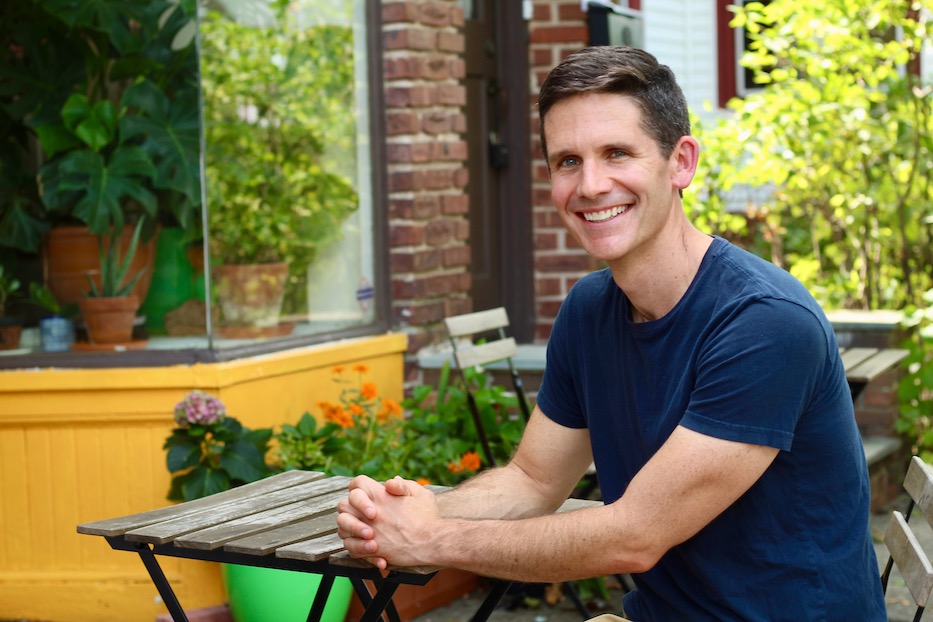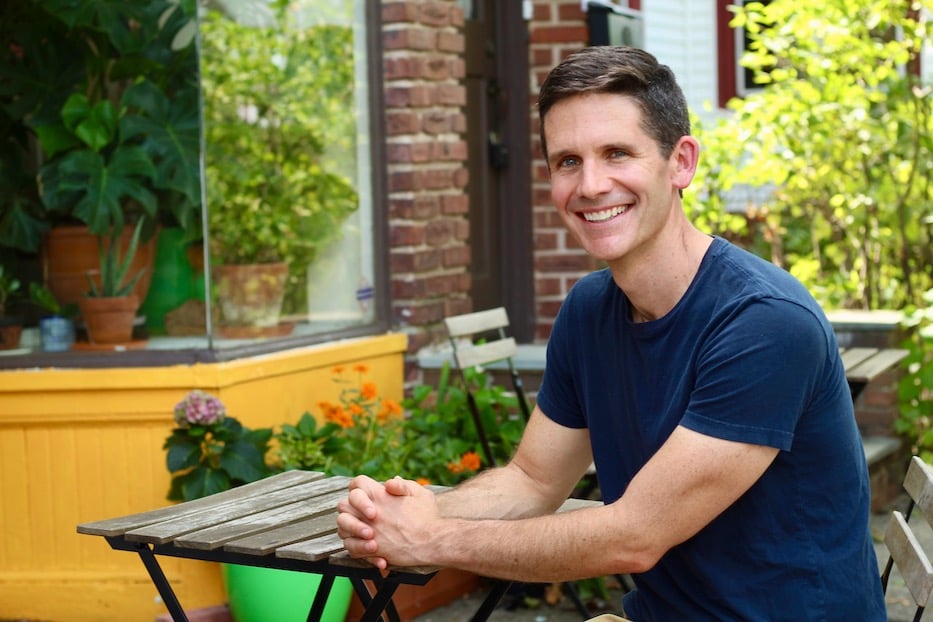
Culture & Community | Education & Youth | Politics | Arts & Culture | Mayoral Campaign 2023

Brennan at Café Flora at BLOOM. "Investing in the arts in schools needs to be something of a priority," he said. Lucy Gellman Photos.
Liam Brennan has seen firsthand the impact that arts education has on his four children at Edgewood School. If elected mayor, he can see using their experience as a template for the city—and thinking about public schools as community centers, after-school arts and programming hubs, and meaningful gathering spaces for city residents.
Brennan is the sole Democratic candidate running against incumbent Mayor Justin Elicker in New Haven's Democratic primary on Tuesday, Sept. 12. Polls open at 6 a.m. and close at 8 p.m. To look up whether and where you are registered to vote, click here.
"I do think that putting funding towards these endeavors, particularly in schools, but in the community as well, is really, really, really important," he said Monday in an interview at Café Flora at BLOOM, as owner Jacob McElligott mixed up iced chai lattes and cold brew coffees inside to beat the heat. "It's giving students the opportunity to have these outlets—and then also our society in general."
"Investing in the arts in schools needs to be something of a priority," he added.
In an interview that jumped from public schools to libraries to placemaking and back, the importance of arts learning was often a through line, yoking K-12 education to a city in which all artists are better supported. More on that below.
Brennan's own connection to the arts began during his childhood in Stamford, when he started piano lessons, and later got into theater and choir in middle and high school. While he chose not to pursue the arts in college—Brennan studied political science at the University of Notre Dame and then attended Yale Law School—he never needed to be convinced of the value of adding arts to the classroom. In the past months, it's been reinforced by several artists working on his campaign, including For La Diáspora co-founder Daniel Pizarro, who designed his logo and lawn sign.
Now, all of his children play the piano, three of the four act faithfully in the musical at Edgewood Creative Thinking through STEAM Magnet School every spring, and two are in the school band. His wife Rebecca Borné, senior engagement and policy fellow at the Consumer Financial Protection Bureau, also plays the piano and guitar and sings. It means that their home in the city's Westville neighborhood is always full of music—and that sometimes, the two watch in wonder as a group of parents become designers, stagehands, and eleventh-hour prop managers when duty calls.
"We have a very arts rich environment," he said, praising Edgewood Principal Nicholas Perrone for understanding how the arts fit into curricular development. "It's just so evident how that can really bring a number of people together and build community."
He added that it was a decision that he and Borné made to opt out of Talented and Gifted (TAG) placement and education for their children that solidified his realization that the arts can be a transformative tool for learning. In 2021—partly in response to their concerns—Edgewood School replaced TAG entirely with its outdoor, arts-heavy ECHO program.
Unlike TAG, which is selective and has been critiqued as racist, classist, and segregationist, ECHO is a weekly arts program open to all students. In weekly class sessions, it includes crafting, weaving, painting, drawing, and outdoor teaching among other activities.
"It is so hard to get my children to talk about school, but they talk about ECHO all the time," he said, smiling as he likened it to an episode of "Abbot Elementary." "They are often talking about what ECHO program they have that semester, who's having it, what days they're having it ... it is so enriching to their experience without segregating them. It really enhances the whole experience for them."
As a candidate for mayor, he said, he can "potentially" see using the ECHO program (or an ECHO analogue) as a sort of citywide template for improving education. During the campaign, he has been vocal about the need for increased recruitment and retention for educators of color and Spanish-speaking teachers, and spoken out about the importance of reading in the midst of a citywide literacy crisis.
He's also interested in the potential schools have—with the proper allocation of city funds—to double as neighborhood hubs and community centers when the school day has ended. Knocking on doors across the city, he said, he's heard residents call consistently for more free and affordable youth programming, particularly after school and in the summers. That's been particularly true in Newhallville, one of the city's most chronically under-resourced neighborhoods.
"A beautiful idea would be to have a Q House everywhere," he said, adding that he'd also love to see a thriving children's museum in the city. "But the Q House is so large! I don't know if there is the demand or if we could sustain a Q House in every neighborhood.”
“One thing to really think about is how we can maximize what we have to double as that,” he continued. “I think the government needs to learn how to be more nimble about those things. Like, how can schools double as community centers in those ways?"
While some of that youth programming may look like sports, he added, it also means more robustly funded arts learning, from theater to marching band. Earlier this year, he watched the impact that musical theater had on students at James Hillhouse High School, who went on to win statewide recognition for their by-the-bootstraps production of Little Shop of Horrors. Monday, he wondered aloud what that kind of program would look like with more dollars behind it.
"I think arts is one of the big ones," he said. "Getting kids excited and involved in making music, making plays, making visual arts is a great way to let them fill their time and build with things that are, like, bubbling up inside of them. It gives them an outlet when they're grappling with all the thoughts and questions and difficulties you have when you're growing up."
What that might look like during a mayoral term is still evolving, he added—but includes greater emphasis on funding the arts in all city public schools, and folding in pathways to social and emotional learning that harness the power of the arts. He again pointed to Hillhouse, where New Haven Public Schools grad Ty Scurry built a drama program on a shoestring budget, and then moved students out of a leaky auditorium to a different school.
What if, Brennan asked aloud, those types of spaces existed throughout the city, for all students?
He noted how arts learning—and the arts well beyond schools—can also be a powerful tool for social justice and cultural competency. In part, he said, he's been inspired by the artists of color who have expressed interest in his campaign, and spoken openly at roundtables and campaign events about feeling locked out or unsupported by many of the city's historically white legacy arts institutions.
He remembered feeling that tension firsthand earlier this year, while attending the opening of Made Visible: Freedom Dreams at Creative Arts Workshop in early February. At the show, curated by nico w. okoro in partnership with the bldg fund, llc, he could see an old-guard—a mostly white, older board of directors—and a new, more progressive wave of artists of color leading the way forward. For him, it was and is indicative of a wider economic and racial divide "that I think city government and city leadership can help bridge."
"I do think one thing the city really needs to be attuned to is tending to the needs and the demands of artists of color," he said. "What we want the city to be is a very successful, functional, multiracial Democracy, and that also needs to be manifested in the arts. That makes us a much stronger and attractive community if we can cultivate and give space to artists and artists of color to fully bloom and be celebrated here."
Getting To One Percent For The NHFPL
Another part of that vision—and one that he sees as inherently yoked to education and lifelong learning—is increased funding and municipal support for the New Haven Free Public Library (NHFPL). As Westville residents, Brennan and his family use the Mitchell Branch Library frequently; it's one of the places his kids are comfortable walking to by themselves. He's also a cinephile, and loves that the library often has one or more film series going at any given time.
That's become particularly true this summer, with the news that New Haven may lose its only remaining all-ages movie theater (the Fairmount Theater, which sits in the Annex, exclusively screens adult films). If elected mayor, he said he would fund the library at a minimum of one percent, which the city currently does not do despite repeated pleas during city budget season.
He'd also love to see extended and Sunday hours, he said—but not particularly at the expense of librarians who are already overworked.
"We need to think about delivering services to people when they are most useful, and Sunday for the library is one of the most useful times to deliver these services to the general public," he said. "And so, that's a really important goal to have with the system. If we're unable to meet that need, then we need to be doing something different.”
Those interests dovetail with a larger vision that does not revolve around, but often folds in, arts and culture as part of a city's civic, social, and spatial fabric. In thinking about the role of placemaking in the city—he was for years a board member of the Community Placemaking & Engagement Network (CPEN)—Brennan said he's for the allocation of more municipal resources on everything from city parks and the New Haven Green to small business corridors to the New Haven Pride Center, which currently has its offices in the basement of a building at 84 Orange St.
He pointed to self-sustaining small business corridors that are woven into neighborhoods, such as Grand and Dixwell Avenues, adding that he believes the city can tap into new and different funding streams, including in the arts and economic development. Currently, the Department of Arts, Culture & Tourism includes New Haven Festivals, Inc., a not-for-profit arm that opens it to sources of arts funding beyond the city's annual allocation.
"Helping those places become more of a place to be with infrastructure investments and artistic investments is really important," he said. "A lot of this is all about the communal experience. Whether it is street art, whether it is sitting here [at Cafe Flora] ... whether it is going to a play ... there is a uniquely human experience about communally intaking art that you don't get from your home, from your living room, and I think that's really important to the foundations of society."

